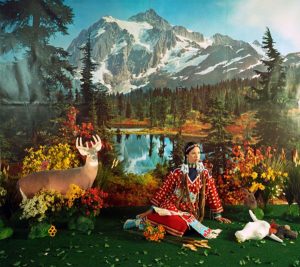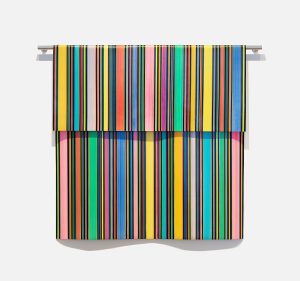Did you know that aside from 2024 MacArthur Fellows Ebony G. Patterson and Wendy Red Star, and 2023 MacArthur Fellows Dyani White Hawk and Raven Chacon, the museum has works by several other Fellows in our collection, and have exhibited or hosted several more? Check them out below!
Martin Puryear – 1989 Fellow
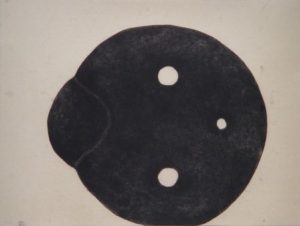
Martin Puryear, Untitled, 1999, etching and aquatint on chine collé, 27 x 32 in. Collection Nerman Museum of Contemporary Art, Johnson County Community College, Overland Park, KS
In addition to having Puryear’s Untitled being part of our collection, this artist was also part of additions/editions in 2000, in JCCC’s Former Gallery of Art.
Guillermo Gómez-Peña – 1991 Fellow
The Nerman Museum, in collaboration with Charlotte Street, hosted Gomez-Peña’s La Pocha Nostra for The Mex Files: A Divination Ritual in 2023.
Wendy Ewald – 1992 Fellow and Dawoud Bey – 2017 Fellow
Bey and Ewald were featured in the 1997 exhibition, Portraits, at JCCC’s Former Gallery of Art.
Kerry James Marshall – 1997 Fellow

Kerry James Marshall, Untitled (Altgeld Gardens), 1995, acrylic and collage on canvas, 79 x 103 in. Collection Nerman Museum of Contemporary Art, Johnson County Community College, Overland Park, KS. Photo: EG Schempf
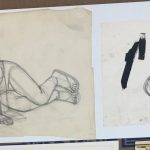
Kerry James Marshall, Studies for Untitled (Altgeld Gardens), 1995, pencil on paper, 11 x 15 1/2 in. and 8 1/2 x 11 in. Collection Nerman Museum of Contemporary Art, Johnson County Community College, Overland Park, KS, Gift of Jack Shainman Gallery, New York, NY
In addition to Marshall’s Untitled (Altgeld Gardens) and Studies for Untitled (Altgeld Gardens) being part of our collection, this artist was also part of several exhibitions at JCCC’s Former Gallery of Art:
Elizabeth Murray – 1999 Fellow

Elizabeth Murray, Landing, 1999, oil on canvas, 115 x 138 in. Collection Nerman Museum of Contemporary Art, Johnson County Community College, Overland Park, KS, Gift of JCCC Gallery Associates
In addition to Murray’s Landing being part of our collection, this artist was also part of several exhibitions at JCCC’s Former Gallery of Art:
In March of 2024, we also hosted a gallery talk about Landing with Jason Andrews, who worked for Murray’s estate.
Toba Khedoori – 2002 Fellow
JCCC’s Former Gallery of Art presented Khedoori’s first institutional exhibition in 1996.
Josiah McElheny – 2006 Fellow
JCCC’s Former Gallery of Art presented Josiah McElheny · Works 1994-2000 in 2001.
Mark Bradford – 2009 Fellow
Bradford was part of queer abstraction in 2019-2020.
Uta Barth – 2012 Fellow

Uta Barth, Untitled (aot 5) from … and of time, 2000, triptych, color photographs, 35 1/4 x 44 1/4 in. Collection Nerman Museum of Contemporary Art, , Johnson County Community College, Overland Park, KS, Gift of Marti and Tony Oppenheimer and the Oppenheimer Brothers Foundation
In addition to Barth’s Untitled (aot 5) from … and of time being part of our collection, this artist was also part of several exhibitions at JCCC’s Former Gallery of Art and at the Nerman Museum:
Nicole Eisenman – 2015 Fellow
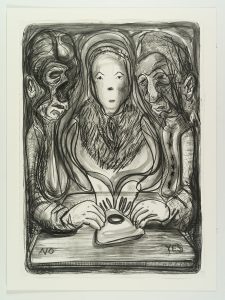
Nicole Eisenman, Ouija, 2014, charcoal, ink, graphite on paper, 36 1/4 x 17 in. Collection Nerman Museum of Contemporary Art, Johnson County Community College, Overland Park, KS, Gift of the H Tony and Marti Oppenheimer Foundation
Eisenman was also part of the Nerman Museum’s REVEAL · Works from the Collection exhibition, which was on view in 2014-2015.
Jeffrey Gibson – 2019 Fellow

Jeffrey Gibson, American Girl, 2013, found punching bag, wool blanket, glass beads, steel studs, artificial sinew, tin jingles and chain, 43 x 16 x 16 in. Collection Nerman Museum of Contemporary Art, Johnson County Community College, Overland Park, KS, Gift of the H Tony and Marti Oppenheimer Foundation. Photo: EG Schempf
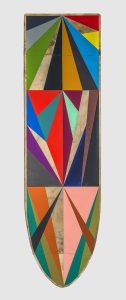
Jeffrey Gibson, Shield, number 1, 2012, found wood ironing board, deer hide, nails, acrylic paint, 58 x 15 3/4 in. Collection Nerman Museum of Contemporary Art, Johnson County Community College, Overland Park, KS, Acquired with funds provided by the Barton P. and Mary D. Cohen Art Acquisition Endowment of the JCCC Foundation. Photo: EG Schempf
In addition to Gibson’s American Girl and Shield, number 1 being part of our collection, this artist was also part of several exhibitions at the Nerman Museum:
We also have a NMOCA InSight video about Shield, number 1.












